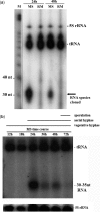Developmentally regulated cleavage of tRNAs in the bacterium Streptomyces coelicolor
- PMID: 18084030
- PMCID: PMC2241913
- DOI: 10.1093/nar/gkm1096
Developmentally regulated cleavage of tRNAs in the bacterium Streptomyces coelicolor
Abstract
The ability to sense and respond to environmental and physiological signals is critical for the survival of the soil-dwelling Gram-positive bacterium Streptomyces coelicolor. Nutrient deprivation triggers the onset of a complex morphological differentiation process that involves the raising of aerial hyphae and formation of spore chains, and coincides with the production of a diverse array of clinically relevant antibiotics and other secondary metabolites. These processes are tightly regulated; however, the genes and signals involved have not been fully elucidated. Here, we report a novel tRNA cleavage event that follows the same temporal regulation as morphological and physiological differentiation, and is growth medium dependent. All tRNAs appear to be susceptible to cleavage; however, there appears to be a bias towards increased cleavage of those tRNAs that specify highly utilized codons. In contrast to what has been observed in eukaryotes, accumulation of tRNA halves in S. coelicolor is not significantly affected by amino acid starvation, and is also not affected by induction of the stringent response or inhibition of ribosome function. Mutants defective in aerial development and antibiotic production exhibit altered tRNA cleavage profiles relative to wild-type strains.
Figures





Similar articles
-
tRNA accumulation and suppression of the bldA phenotype during development in Streptomyces coelicolor.Mol Microbiol. 2011 Mar;79(6):1602-14. doi: 10.1111/j.1365-2958.2011.07543.x. Epub 2011 Jan 27. Mol Microbiol. 2011. PMID: 21244529
-
A genetic and bioinformatic analysis of Streptomyces coelicolor genes containing TTA codons, possible targets for regulation by a developmentally significant tRNA.FEMS Microbiol Lett. 2007 Jan;266(1):20-8. doi: 10.1111/j.1574-6968.2006.00494.x. Epub 2006 Nov 14. FEMS Microbiol Lett. 2007. PMID: 17100986
-
A Regulatory Gene SCO2140 is Involved in Antibiotic Production and Morphological Differentiation of Streptomyces coelicolor A3(2).Curr Microbiol. 2016 Aug;73(2):196-201. doi: 10.1007/s00284-016-1050-8. Epub 2016 Apr 25. Curr Microbiol. 2016. PMID: 27113590
-
Signals and regulators that govern Streptomyces development.FEMS Microbiol Rev. 2012 Jan;36(1):206-31. doi: 10.1111/j.1574-6976.2011.00317.x. Epub 2011 Dec 2. FEMS Microbiol Rev. 2012. PMID: 22092088 Free PMC article. Review.
-
The Gene bldA, a regulator of morphological differentiation and antibiotic production in streptomyces.Arch Pharm (Weinheim). 2015 Jul;348(7):455-62. doi: 10.1002/ardp.201500073. Epub 2015 Apr 27. Arch Pharm (Weinheim). 2015. PMID: 25917027 Review.
Cited by
-
Cicada Endosymbionts Have tRNAs That Are Correctly Processed Despite Having Genomes That Do Not Encode All of the tRNA Processing Machinery.mBio. 2019 Jun 18;10(3):e01950-18. doi: 10.1128/mBio.01950-18. mBio. 2019. PMID: 31213566 Free PMC article.
-
Identification and functional characterization of tRNA-derived RNA fragments (tRFs) in respiratory syncytial virus infection.Mol Ther. 2013 Feb;21(2):368-79. doi: 10.1038/mt.2012.237. Epub 2012 Nov 27. Mol Ther. 2013. PMID: 23183536 Free PMC article.
-
tRNA-derived fragments target the ribosome and function as regulatory non-coding RNA in Haloferax volcanii.Archaea. 2012;2012:260909. doi: 10.1155/2012/260909. Epub 2012 Dec 27. Archaea. 2012. PMID: 23326205 Free PMC article.
-
A pseudo-tRNA modulates antibiotic resistance in Bacillus cereus.PLoS One. 2012;7(7):e41248. doi: 10.1371/journal.pone.0041248. Epub 2012 Jul 18. PLoS One. 2012. PMID: 22815980 Free PMC article.
-
High-throughput detection of RNA processing in bacteria.BMC Genomics. 2018 Mar 27;19(1):223. doi: 10.1186/s12864-018-4538-8. BMC Genomics. 2018. PMID: 29587634 Free PMC article.
References
-
- Elliot MA, Buttner MJ, Nodwell JR. Multicellular development in Streptomyces. In: Whitworth DE, editor. Myxobacteria: Multicellularity and Differentiation. Washington, D.C.: ASM Press; 2007. pp. 419–438.
-
- Claessen D, de Jong W, Dijkhuizen L, Wosten HAB. Regulation of Streptomyces development: reach for the sky! Trends Microbiol. 2006;14:313–319. - PubMed
-
- Kelemen GH, Buttner MJ. Initiation of aerial mycelium formation in Streptomyces. Curr. Opin. Microbiol. 1998;1:656–662. - PubMed
-
- Pope MK, Green BD, Westpheling J. The bld mutants of Streptomyces coelicolor are defective in the regulation of carbon utilization, morphogenesis and cell-cell signalling. Mol. Microbiol. 1996;19:747–756. - PubMed
-
- Rigali S, Nothaft H, Noens EEE, Schlicht M, Colson S, Müller M, Joris B, Koerten HK, Hopwood DA, et al. The sugar phosphotransferase system of Streptomyces coelicolor is regulated by the GntR-family regulator DasR and links N-acetylglucosamine metabolism to the control of development. Mol. Microbiol. 2006;61:1237–1251. - PubMed
Publication types
MeSH terms
Substances
LinkOut - more resources
Full Text Sources
Other Literature Sources

